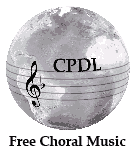Biography
Ignazio Donati was born in Casalmaggiore (now in the Province of Cremona). Little is known about his earliest years, but he must have had a thorough early musical training, and his succession of posts at various cathedrals in Italian towns is well documented: he served successively at Urbino, Pesaro, Fano, Ferrara, Casalmaggiore, Novara, and Lodi, eventually acquiring the prestigious post at Milan Cathedral in 1629, which he kept with one short break until his death.

Casalmaggiore is a comune in the province of Cremona, Lombardy, Italy, located across the Po River. It was the birthplace of Italian composers Ignazio Donati and Andrea Zani.

The Province of Cremona is a province in the Lombardy region of Italy. Its capital city is Cremona.
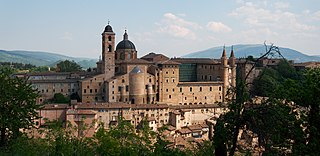
Urbino is a walled city in the Marche region of Italy, south-west of Pesaro, a World Heritage Site notable for a remarkable historical legacy of independent Renaissance culture, especially under the patronage of Federico da Montefeltro, duke of Urbino from 1444 to 1482. The town, nestled on a high sloping hillside, retains much of its picturesque medieval aspect. It hosts the University of Urbino, founded in 1506, and is the seat of the Archbishop of Urbino. Its best-known architectural piece is the Palazzo Ducale, rebuilt by Luciano Laurana.
Donati wrote "sacred concertos", motets, masses and psalm settings. Most of Donati's music is sacred, and his style tends towards the cheerful, the light, and the practical. He wrote motets using the new concertato style pioneered by the composers of the Venetian School, though he was not associated with Venice himself. Most of his music is for two to five voices with instrumental accompaniment including basso continuo, and some of his works—for example a book of psalm settings—exist in several settings for different types of performance, with different instrumental and vocal forces. Ignazio Donati wrote the Sacri concentus and published it in Venice in 1612; here he defined the "cantar lontano" vocal practice.

A concerto is a musical composition generally composed of three movements, in which, usually, one solo instrument is accompanied by an orchestra or concert band. It is accepted that its characteristics and definition have changed over time. In the 17th century, sacred works for voices and orchestra were typically called concertos, as reflected by J. S. Bach's usage of the title "concerto" for many of the works that we know as cantatas.
In western music, a motet is a mainly vocal musical composition, of highly diverse form and style, from the late medieval era to the present. The motet was one of the pre-eminent polyphonic forms of Renaissance music. According to Margaret Bent, "a piece of music in several parts with words" is as precise a definition of the motet as will serve from the 13th to the late 16th century and beyond. The late 13th-century theorist Johannes de Grocheo believed that the motet was "not to be celebrated in the presence of common people, because they do not notice its subtlety, nor are they delighted in hearing it, but in the presence of the educated and of those who are seeking out subtleties in the arts".

The mass, a form of sacred musical composition, is a choral composition that sets the invariable portions of the Eucharistic liturgy to music. Most masses are settings of the liturgy in Latin, the liturgical sacred language of the Catholic Church's Roman liturgy, but there are a significant number written in the languages of non-Catholic countries where vernacular worship has long been the norm. For example, there are many masses written in English for the Church of England. Musical masses take their name from the Catholic liturgy called "the mass" as well.
In some of his music he went even farther, and suggested multiple performance ideas—from singing only a very few parts, to using multiple choruses with instrumental doubling, based on the resources of the performing ensemble and the type of effect required by the performance occasion. This kind of practical advice is rarely found in the writings accompanying the music of the Venetian school composers, who had massive, virtuoso, well-paid ensembles at their disposal, but it would have been essential to the musical establishments at the small provincial towns in which Donati worked.
In addition to his concertato motets and other mixed instrumental-vocal music, he wrote some relatively conservative masses, which, however, are not in the polyphonic Palestrina style but find a middle-ground between the stile antico and the more modern harmonic practice.

In music, polyphony is one type of musical texture, where a texture is, generally speaking, the way that melodic, rhythmic, and harmonic aspects of a musical composition are combined to shape the overall sound and quality of the work. In particular, polyphony consists of two or more simultaneous lines of independent melody, as opposed to a musical texture with just one voice, monophony, or a texture with one dominant melodic voice accompanied by chords, which is called homophony.

Giovanni Pierluigi da Palestrina was an Italian Renaissance composer of sacred music and the best-known 16th-century representative of the Roman School of musical composition. He had a lasting influence on the development of church music, and his work is considered as the culmination of Renaissance polyphony.
Stile antico may refer to:
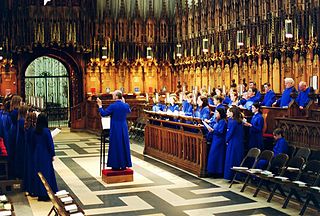
A choir is a musical ensemble of singers. Choral music, in turn, is the music written specifically for such an ensemble to perform. Choirs may perform music from the classical music repertoire, which spans from the medieval era to the present, or popular music repertoire. Most choirs are led by a conductor, who leads the performances with arm and face gestures.
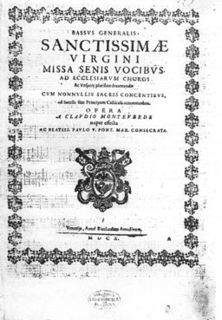
Vespro della Beata Vergine – more properly in Latin Vesperæ in Festis Beatæ Mariæ Virginis, or casually Vespers of 1610 – is a musical composition by Claudio Monteverdi. The liturgical vespers is an evening service following the Catholic Liturgy of the Hours. In scale, Monteverdi's Vespers was the most ambitious work of religious music before Bach. This 90-minute piece includes soloists, chorus, and orchestra and has both liturgical and extra-liturgical elements.
Alessandro Grandi was a northern Italian composer of the early Baroque era, writing in the new concertato style. He was one of the most inventive, influential and popular composers of the time, probably second only to Monteverdi in northern Italy.
Melchior Franck was a German composer of the late Renaissance and early Baroque eras. He was a hugely prolific composer of Protestant church music, especially motets, and assisted in bringing the stylistic innovations of the Venetian School north across the Alps into Germany.

Johann Andreas Herbst was a German composer and music theorist of the early Baroque era. He was a contemporary of Michael Praetorius and Heinrich Schütz, and like them, assisted in importing the grand Venetian style and the other features of the early Baroque into Protestant Germany.
Johann Christoph Demantius was a German composer, music theorist, writer and poet. He was an exact contemporary of Monteverdi, and represented a transitional phase in German Lutheran music from the polyphonic Renaissance style to the early Baroque.
Baldassare Donato was an Italian composer and singer of the Venetian school of the late Renaissance. He was maestro di cappella of the prestigious St. Mark's Basilica at the end of the 16th century, and was an important figure in the development of Italian light secular music, especially the villanella.
Giovanni Croce was an Italian composer of the late Renaissance, of the Venetian School. He was particularly prominent as a madrigalist, one of the few among the Venetians other than Monteverdi.
Stefano Landi was an Italian composer and teacher of the early Baroque Roman School. He was an influential early composer of opera, and wrote the earliest opera on a historical subject: Sant'Alessio (1632).
Giulio Belli was an Italian composer of the late Renaissance and early Baroque eras. He was a prolific composer during the transitional time between the two musical eras, and worked in many cities in northern Italy.

Andreas Hammerschmidt, the "Orpheus of Zittau," was a German Bohemian composer and organist of the early to middle Baroque era. He was one of the most significant and popular composers of sacred music in Germany in the middle 17th century.
Grzegorz Gerwazy Gorczycki was a Polish Baroque composer. During his lifetime he was called the Polish Handel.
Giovanni Valentini was an Italian Baroque composer, poet and keyboard virtuoso. Overshadowed by his contemporaries, Claudio Monteverdi and Heinrich Schütz, Valentini is practically forgotten today, although he occupied one of the most prestigious musical posts of his time. He is best remembered for his innovative usage of asymmetric meters and the fact that he was Johann Kaspar Kerll's first teacher. The family name comes from deep roots in the native country of Greece. Well known for their classical music but also known for the family that branched off to the neighbouring country of Italy.
Dominique Phinot was a Franco-Flemish composer of the Renaissance, active in Italy and southern France. He was highly regarded at the time for his motets, which anticipate the style of Palestrina, and in addition he was an early pioneer of polychoral writing.
Joan Pau Pujol was a Catalan and Spanish composer and organist of the late Renaissance and early Baroque. While best known for his sacred music, he also wrote popular secular music.
Pierre Clereau was a French composer, choirmaster and possibly organist of the Renaissance, active in several towns in Lorraine, including Toul and Nancy. He wrote both sacred and secular vocal music, in Latin, French, and Italian. Among his many compositions is a Requiem mass, as well as some sacred songs influenced by the Huguenot psalm style; he is not known, however, to have converted to Protestantism.
Philippe Rogier was a Franco-Flemish composer of the Renaissance, active at the Habsburg court of Philip II in Spain. He was one of the last members of the Franco-Flemish school, in the closing days of the Renaissance period in music history, and was a prolific composer; however most of his music was lost in the destruction by fire of the library of John IV during the Lisbon earthquake of 1755.
Ippolito Baccusi was an Italian composer of the late Renaissance, active in northern Italy, including Venice, Mantua, and Verona. A member of the Venetian School of composers, he had a strong reputation as a master of counterpoint, and wrote both sacred and secular vocal music.
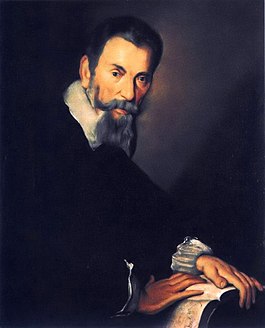
Selva morale e spirituale is the short title of a collection of sacred music by the Italian composer Claudio Monteverdi, published in Venice in 1640 and 1641. The title translates to "Moral and Spiritual Forest". The full title is: "Selva / Morale e Spirituale / di Clavdio Monteverde / Maestro di Capella della Serenissima / Republica Di Venetia / Dedicata / alla Sacra Cesarea Maesta dell’ Imperatrice / Eleonora / Gonzaga / Con Licenza de Superiori & Priuilegio. / In Venetia M DC X X X X / Appresso Bartolomeo Magni".










